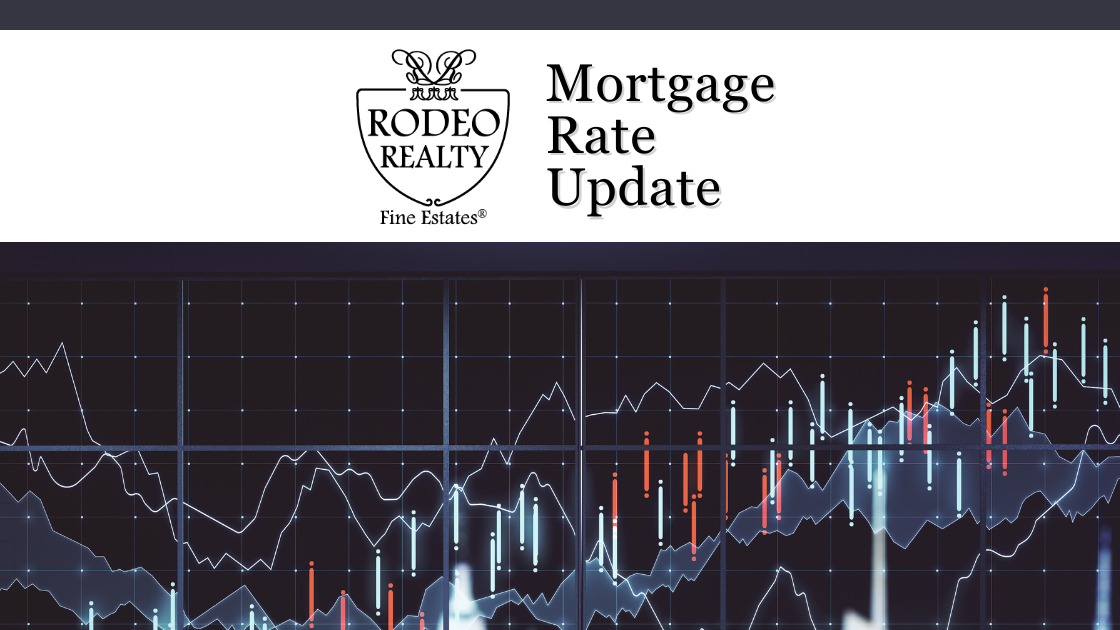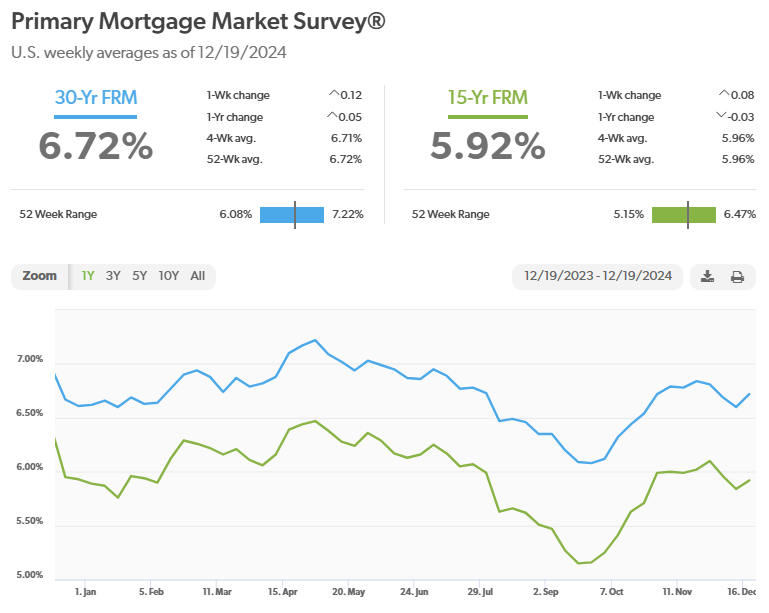Stocks surged, inflation moderated, and mortgage rates remained high in 2024
The Fed dropped their key interest rates by 1% in 2024 – The Fed began raising their key interest rates in 2022. They had increased rates to a 24-year high to combat inflation before a ½% drop in September, a ¼% drop in November, and a ¼% drop in December. Federal Reserve Chairman Powell said at the end of the year that he only expects two additional rate drops in 2025 and that rates would remain above “neutral levels” for the foreseeable future because inflation has picked up since hitting a 3-year low in September. He also said that the economy and job market were stronger than expected and that the Fed does not expect inflation to drop to its 2% annual rate target until 2026. The Consumer Price Index (CPI) showed that consumer prices increased 2.7% year-over-year in November, up from a 2.6% year-over-year increase in October. The CPI peaked at 9.1% in June 2022 and has worked its way down to a 2.4% year-over-year increase in September but has ticked up the last two months. We are well below the CPI rate of 3.4% in December 2023, so we have moved in the right direction. Core CPI,which excludes volatile food and energy costs rose 3.3% year-over-year in November for the fourth consecutive month. That is down from 3.9% in December 2023. The Personal Consumption Expenditures Index (PCE), the Fed’s preferred measure of inflation, showed that consumer prices rose 2.4% in November from one year ago. Excluding food and energy Core PCE increased 2.8% year-over-year.
The graph below shows the CPI rate since 2021:

![]()
Stocks surged and Stock markets hit record highs in 2024 – All three indexes hit record highs in 2024 but closed the year off their record highs after the Fed announced that they were concerned that inflation had heated up and they were going to stall rate drops in 2025. The DowJones Industrial Average ended the year at 42,544.72, up 12.9% from 37,689.40 on December 31, 2023. The S&P 500 closed the year at 5,881.63, up 23.3% from 4,769.89 on December 31, 2023. The NASDAQ closed at 19,310.79, up 28.6% from 15,011.35 at the end of 2023.
U.S. Treasury Bond Yields increased in 2024 – Bond yields increased in the first six months of the year. As the inflation ratesdropped to their lowest levels since 2021 in September bond yields also dropped to their lowest levels of the year but increased in November and December to end the year higher than where they began the year. While the inflation rate is lower than it was a year ago the amount of the national debt has made treasury bonds less attractive and has pushed up rates. The 10-year U.S. treasury bond yield closed the year at 4.58%, up from 3.88% On December 31, 2023. The 30-year treasury yield ended the year at 4.78%, up from 4.03% on Dec. 31, 2023. We watch bond yields because mortgage rates often follow treasury bond yields.
Mortgage rates – Mortgage rates began the year with the 30-year at 6.61%, by September it dropped to 6% but increased to end the year to 6.85%. Many people have asked, “Why have mortgage rates increased if the Fed has lowered rates by 1%?” That is an interesting question. The Fed controls overnight rates that banks pay to borrow money overnight from the Federal Reserve. That is the shortest-term rate. When overnight rates drop, banks drop their “prime” lending rate which is offered to their best customers. The prime rate is a common index for lines of credit. Those did drop 1%. Mortgages are long-term rates. Investors try to forecast inflation over a long period when purchasing mortgages. They need a spread over the inflation rate that they forecast. With the economy picking up steam, more jobs available than workers looking for work, and consumer spending higher long-term risk of inflation is higher. Every Thursday Freddie Mac publishes interest rates based on a survey of mortgage lenders throughout the week. The Freddie Mac Primary Mortgage Survey reported that mortgage rates for the most popular loan products as of December 26th, 2024, were as follows: The 30-year fixed mortgage rate was 6.85%, up from 6.61% on December 28, 2023. The 15-year fixed was 6%, up from 5.93% on December 28, 2023.
The graph below shows the trajectory of mortgage rates over the past year:
![]()

Home sales data is released on the third week of the month for the previous month by the California Association of Realtors and the National Association of Realtors. These are November’s home sales figures.
U.S. existing-home sales November 2024 – National home prices rose about 5% in 2024 – The National Association of Realtors reported that existing-home sales totaled 4.15 million units on a seasonally annualized rate in November, up 4.8% from 3.96 million units on a seasonally adjusted annualized rate in October, and up 6.1% from an annualized rate of 3.91-million units last November. The median price for a home sold in the U.S. in November was $406,100, up 4.7% from $387,800 one year ago. There was a 3.8-month supply of homes for sale in November, down from a 4.2-month supply in October, and up from a 3.5-month supply one year ago. First-time buyers accountedfor 30% of all sales. Investors and second-home purchases accounted for 13% of all sales. All cash purchases accounted for 25% of all sales. Foreclosures and short sales accounted for 2% of all sales.
California existing-home sales – Housing prices rose about 4% in 2024 – The California Association of Realtors reported that existing-home sales totaled 267,800on an annualized basis in November, up 1.1% from 264,870 on an annualized basis in October, and up 19.5% from a revised 224,140 homes sold on an annualized basis last November. The statewide median price paid for a home was $852,880 in November, down 4% from $888,740 in October, and up 3.8% from $821,710 one year ago. There was a 3.3-month supply of homes for sale in November, up from a 2.9-month supply in November 2023.
The graph below lists home sales data by county in Southern California:


















